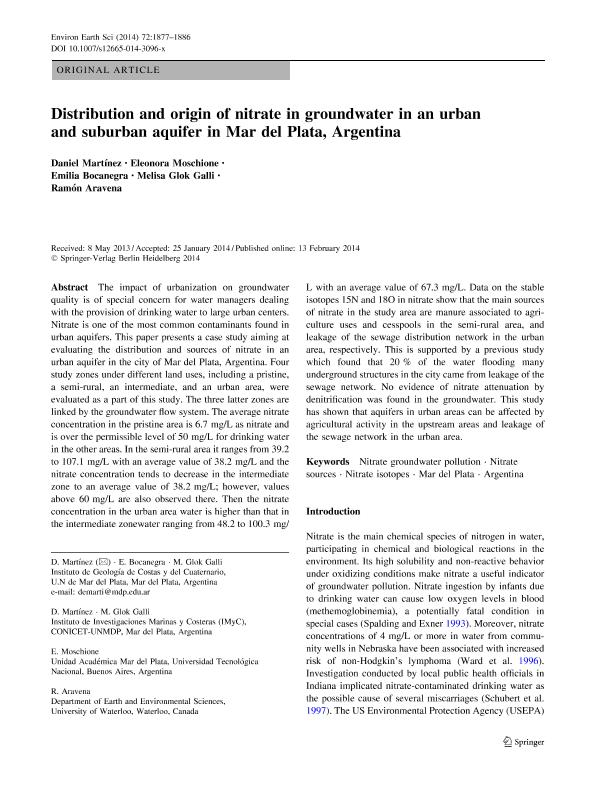Mostrar el registro sencillo del ítem
dc.contributor.author
Martinez, Daniel Emilio

dc.contributor.author
Moschione, Eleonora
dc.contributor.author
Bocanegra, Emilia María

dc.contributor.author
Glok Galli, Melisa

dc.contributor.author
Aravena, Ramón
dc.date.available
2020-06-19T19:41:47Z
dc.date.issued
2014-09
dc.identifier.citation
Martinez, Daniel Emilio; Moschione, Eleonora; Bocanegra, Emilia María; Glok Galli, Melisa; Aravena, Ramón; Distribution and origin of nitrate in groundwater in an urban and suburban aquifer in Mar del Plata, Argentina; Springer; Environmental Earth Sciences; 72; 6; 9-2014; 1877-1886
dc.identifier.issn
1866-6280
dc.identifier.uri
http://hdl.handle.net/11336/107756
dc.description.abstract
The impact of urbanization on groundwater quality is of special concern for water managers dealing with the provision of drinking water to large urban centers. Nitrate is one of the most common contaminants found in urban aquifers. This paper presents a case study aiming at evaluating the distribution and sources of nitrate in an urban aquifer in the city of Mar del Plata, Argentina. Four study zones under different land uses, including a pristine, a semi-rural, an intermediate, and an urban area, were evaluated as a part of this study. The three latter zones are linked by the groundwater flow system. The average nitrate concentration in the pristine area is 6.7 mg/L as nitrate and is over the permissible level of 50 mg/L for drinking water in the other areas. In the semi-rural area it ranges from 39.2 to 107.1 mg/L with an average value of 38.2 mg/L and the nitrate concentration tends to decrease in the intermediate zone to an average value of 38.2 mg/L; however, values above 60 mg/L are also observed there. Then the nitrate concentration in the urban area water is higher than that in the intermediate zonewater ranging from 48.2 to 100.3 mg/L with an average value of 67.3 mg/L. Data on the stable isotopes 15N and 18O in nitrate show that the main sources of nitrate in the study area are manure associated to agriculture uses and cesspools in the semi-rural area, and leakage of the sewage distribution network in the urban area, espectively. This is supported by a previous study which found that 20 % of the water flooding many underground structures in the city came from leakage of the sewage network. No evidence of nitrate attenuation by denitrification was found in the groundwater. This study has shown that aquifers in urban areas can be affected by agricultural activity in the upstream areas and leakage of the sewage network in the urban area.
dc.format
application/pdf
dc.language.iso
eng
dc.publisher
Springer

dc.rights
info:eu-repo/semantics/openAccess
dc.rights.uri
https://creativecommons.org/licenses/by-nc-sa/2.5/ar/
dc.subject
NITRATE GROUNDWATER POLLUTION
dc.subject
NITRATE SOURCES
dc.subject
NITRATE ISOTOPES
dc.subject
MAR DEL PLATA
dc.subject
ARGENTINA
dc.subject.classification
Oceanografía, Hidrología, Recursos Hídricos

dc.subject.classification
Ciencias de la Tierra y relacionadas con el Medio Ambiente

dc.subject.classification
CIENCIAS NATURALES Y EXACTAS

dc.title
Distribution and origin of nitrate in groundwater in an urban and suburban aquifer in Mar del Plata, Argentina
dc.type
info:eu-repo/semantics/article
dc.type
info:ar-repo/semantics/artículo
dc.type
info:eu-repo/semantics/publishedVersion
dc.date.updated
2020-05-11T15:45:53Z
dc.journal.volume
72
dc.journal.number
6
dc.journal.pagination
1877-1886
dc.journal.pais
Alemania

dc.description.fil
Fil: Martinez, Daniel Emilio. Universidad Nacional de Mar del Plata. Facultad de Ciencias Exactas y Naturales. Instituto de Geología de Costas y del Cuaternario. Provincia de Buenos Aires. Gobernación. Comisión de Investigaciones Científicas. Instituto de Geología de Costas y del Cuaternario; Argentina. Consejo Nacional de Investigaciones Científicas y Técnicas. Centro Científico Tecnológico Conicet - Mar del Plata. Instituto de Investigaciones Marinas y Costeras. Universidad Nacional de Mar del Plata. Facultad de Ciencias Exactas y Naturales. Instituto de Investigaciones Marinas y Costeras; Argentina
dc.description.fil
Fil: Moschione, Eleonora. Universidad Tecnológica Nacional. Centro de Estudios Mar del Plata; Argentina
dc.description.fil
Fil: Bocanegra, Emilia María. Universidad Nacional de Mar del Plata. Facultad de Ciencias Exactas y Naturales. Instituto de Geología de Costas y del Cuaternario. Provincia de Buenos Aires. Gobernación. Comisión de Investigaciones Científicas. Instituto de Geología de Costas y del Cuaternario; Argentina
dc.description.fil
Fil: Glok Galli, Melisa. Consejo Nacional de Investigaciones Científicas y Técnicas. Centro Científico Tecnológico Conicet - Mar del Plata. Instituto de Investigaciones Marinas y Costeras. Universidad Nacional de Mar del Plata. Facultad de Ciencias Exactas y Naturales. Instituto de Investigaciones Marinas y Costeras; Argentina. Universidad Nacional de Mar del Plata. Facultad de Ciencias Exactas y Naturales. Instituto de Geología de Costas y del Cuaternario. Provincia de Buenos Aires. Gobernación. Comisión de Investigaciones Científicas. Instituto de Geología de Costas y del Cuaternario; Argentina
dc.description.fil
Fil: Aravena, Ramón. University of Waterloo; Canadá
dc.journal.title
Environmental Earth Sciences
dc.relation.alternativeid
info:eu-repo/semantics/altIdentifier/url/http://link.springer.com/article/10.1007/s12665-014-3096-x
dc.relation.alternativeid
info:eu-repo/semantics/altIdentifier/doi/http://dx.doi.org/10.1007/s12665-014-3096-x
Archivos asociados
